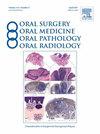口腔鳞状细胞癌模拟颌骨药物相关骨坏死(MRONJ):一个病例系列
Oral surgery, oral medicine, oral pathology, oral radiology, and endodontics
Pub Date : 2021-11-03
DOI:10.3390/oral1040032
引用次数: 3
摘要
(1)背景:药物相关性颌骨骨坏死(MRONJ)是抗吸收和/或抗血管生成治疗的潜在药物不良反应。MRONJ主要通过记忆资料、临床检查和放射学表现诊断,体征和症状往往不明确。另一方面,口腔鳞状细胞癌(OSCC)以其多形性外观为特征(如溃疡、黏膜开裂、拔牙后窝不愈合)。我们报告三例OSCC模拟MRONJ病变。(2)患者:3例接受氨基双膦酸盐治疗的骨质疏松患者出现颌骨口内暴露区和与MRONJ相符的非特异性影像学征象。因临床怀疑为恶性病变,同时行切口活检进行组织学检查。(3)结果:组织标本组织学检查显示存在OSCC。所有患者都接受了癌症治疗。(4)结论:在有抗吸收史的患者中,OSCC的几种体征和症状可能模拟MRONJ;由于这些原因,当临床医生面对可疑的恶性病变时,进行组织学分析是很重要的。本文章由计算机程序翻译,如有差异,请以英文原文为准。
Oral Squamous Cell Carcinoma Mimicking Medication-Related Osteonecrosis of the Jaws (MRONJ): A Case Series
(1) Background: Medication-related osteonecrosis of the jaw (MRONJ) is a potential adverse drug reaction of antiresorptive and/or antiangiogenic treatment. MRONJ is mostly diagnosed by anamnestic data, clinical examination and radiological findings, with signs and symptoms often unspecific. On the other hand, oral squamous cell carcinoma (OSCC) is characteristic for its pleomorphic appearance (e.g., ulcer, mucous dehiscence, non-healing post-extractive socket). We report three cases where OSCC mimicked MRONJ lesions. (2) Patients: Three patients undergoing amino-bisphosphonate treatment for osteoporosis presented with areas of intraorally exposed jawbone and unspecific radiological signs compatible with MRONJ. Due to the clinical suspicious of malignant lesion, incisional biopsy for histological examination was also performed. (3) Results: Histological examination of the tissue specimen revealed the presence of OSCC. All patients underwent cancer treatment. (4) Conclusions: Several signs and symptoms of OSCC may simulate, in patients with a history of anti-resorptive, MRONJ; for these reasons, it is important to perform histologic analysis when clinicians are facing a suspicious malignant lesion.
求助全文
通过发布文献求助,成功后即可免费获取论文全文。
去求助
来源期刊
自引率
0.00%
发文量
0
审稿时长
1 months

 求助内容:
求助内容: 应助结果提醒方式:
应助结果提醒方式:


